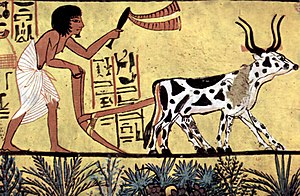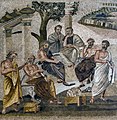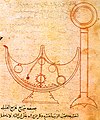Portal:History of science
The History of Science Portal
The history of science covers the development of science from ancient times to the present. It encompasses all three major branches of science: natural, social, and formal. Protoscience, early sciences, and natural philosophies such as alchemy and astrology during the Bronze Age, Iron Age, classical antiquity, and the Middle Ages declined during the early modern period after the establishment of formal disciplines of science in the Age of Enlightenment.
Science's earliest roots can be traced to Ancient Egypt and Mesopotamia around 3000 to 1200 BCE. These civilizations' contributions to mathematics, astronomy, and medicine influenced later Greek natural philosophy of classical antiquity, wherein formal attempts were made to provide explanations of events in the physical world based on natural causes. After the fall of the Western Roman Empire, knowledge of Greek conceptions of the world deteriorated in Latin-speaking Western Europe during the early centuries (400 to 1000 CE) of the Middle Ages, but continued to thrive in the Greek-speaking Byzantine Empire. Aided by translations of Greek texts, the Hellenistic worldview was preserved and absorbed into the Arabic-speaking Muslim world during the Islamic Golden Age. The recovery and assimilation of Greek works and Islamic inquiries into Western Europe from the 10th to 13th century revived the learning of natural philosophy in the West. Traditions of early science were also developed in ancient India and separately in ancient China, the Chinese model having influenced Vietnam, Korea and Japan before Western exploration. Among the Pre-Columbian peoples of Mesoamerica, the Zapotec civilization established their first known traditions of astronomy and mathematics for producing calendars, followed by other civilizations such as the Maya.
Natural philosophy was transformed during the Scientific Revolution in 16th- to 17th-century Europe, as new ideas and discoveries departed from previous Greek conceptions and traditions. The New Science that emerged was more mechanistic in its worldview, more integrated with mathematics, and more reliable and open as its knowledge was based on a newly defined scientific method. More "revolutions" in subsequent centuries soon followed. The chemical revolution of the 18th century, for instance, introduced new quantitative methods and measurements for chemistry. In the 19th century, new perspectives regarding the conservation of energy, age of Earth, and evolution came into focus. And in the 20th century, new discoveries in genetics and physics laid the foundations for new sub disciplines such as molecular biology and particle physics. Moreover, industrial and military concerns as well as the increasing complexity of new research endeavors ushered in the era of "big science," particularly after World War II. (Full article...)
Selected article -

Agriculture began independently in different parts of the globe, and included a diverse range of taxa. At least eleven separate regions of the Old and New World were involved as independent centers of origin. The development of agriculture about 12,000 years ago changed the way humans lived. They switched from nomadic hunter-gatherer lifestyles to permanent settlements and farming.
Wild grains were collected and eaten from at least 104,000 years ago. However, domestication did not occur until much later. The earliest evidence of small-scale cultivation of edible grasses is from around 21,000 BC with the Ohalo II people on the shores of the Sea of Galilee. By around 9500 BC, the eight Neolithic founder crops – emmer wheat, einkorn wheat, hulled barley, peas, lentils, bitter vetch, chickpeas, and flax – were cultivated in the Levant. Rye may have been cultivated earlier, but this claim remains controversial. Regardless, rye's spread from Southwest Asia to the Atlantic was independent of the Neolithic founder crop package. Rice was domesticated in China by 6200 BC with earliest known cultivation from 5700 BC, followed by mung, soy and azuki beans. Rice was also independently domesticated in West Africa and cultivated by 1000 BC. Pigs were domesticated in Mesopotamia around 11,000 years ago, followed by sheep. Cattle were domesticated from the wild aurochs in the areas of modern Turkey and India around 8500 BC. Camels were domesticated late, perhaps around 3000 BC. (Full article...)
Selected image

ENIAC, short for Electronic Numerical Integrator and Computer, was the first large-scale, electronic, digital computer capable of being reprogrammed to solve a full range of computing problems, although earlier computers had been built with some of these properties. ENIAC was designed and built to calculate artillery firing tables for the U.S. Army's Ballistics Research Laboratory. The first problems run on the ENIAC however, were related to the design of the hydrogen bomb.
This photo has been artificially darkened, obscuring details such as the women who were present and the IBM equipment in use. The original photo can be seen in the article: Rose, Allen (April 1946). "Lightning Strikes Mathematics". Popular Science: 83–86. Retrieved 15 April 2012.
Did you know
...that the travel narrative The Malay Archipelago, by biologist Alfred Russel Wallace, was used by the novelist Joseph Conrad as a source for his novel Lord Jim?
...that the seventeenth century philosophers René Descartes, Baruch Spinoza, and Gottfried Leibniz, along with their Empiricist contemporary Thomas Hobbes all formulated definitions of conatus, an innate inclination of a thing to continue to exist and enhance itself?
...that according to the controversial Hockney-Falco thesis, the rise of realism in Renaissance art, such as Jan Van Eyck's Arnolfini Portrait (pictured), was largely due to the use of curved mirrors and other optical aids?
Selected Biography -
Sir Isaac Newton FRS (25 December 1642 – 20 March 1726/27) was an English polymath active as a mathematician, physicist, astronomer, alchemist, theologian, and author who was described in his time as a natural philosopher. He was a key figure in the Scientific Revolution and the Enlightenment that followed. His pioneering book Philosophiæ Naturalis Principia Mathematica (Mathematical Principles of Natural Philosophy), first published in 1687, achieved the first great unification in physics and established classical mechanics. Newton made seminal contributions to optics, and shares credit with German mathematician Gottfried Wilhelm Leibniz for formulating infinitesimal calculus, though he developed calculus years before Leibniz. He contributed to and refined the scientific method, and his work is considered the most influential in bringing forth modern science.
In the Principia, Newton formulated the laws of motion and universal gravitation that formed the dominant scientific viewpoint for centuries until it was superseded by the theory of relativity. He used his mathematical description of gravity to derive Kepler's laws of planetary motion, account for tides, the trajectories of comets, the precession of the equinoxes and other phenomena, eradicating doubt about the Solar System's heliocentricity. He demonstrated that the motion of objects on Earth and celestial bodies could be accounted for by the same principles. Newton's inference that the Earth is an oblate spheroid was later confirmed by the geodetic measurements of Maupertuis, La Condamine, and others, convincing most European scientists of the superiority of Newtonian mechanics over earlier systems. (Full article...)
Selected anniversaries
- 1602 – Birth of Otto von Guericke, German physicist (d. 1686)
- 1704 – Death of Charles Plumier, French botanist (b. 1646)
- 1764 – Death of Christian Goldbach, Prussian mathematician (b. 1690)
- 1778 – Death of Francesco Cetti, Italian Jesuit scientist (b. 1726)
- 1841 – Birth of Victor D'Hondt, Belgian mathematician (d. 1901)
- 1856 – Death of Farkas Bolyai, Hungarian mathematician (b. 1775)
- 1877 – Thomas Edison announces his invention of the phonograph, a machine that can record and play sound
- 1886 – Birth of Karl von Frisch, Austrian zoologist, Nobel laureate (d. 1982)
- 1889 – Birth of Edwin Hubble, American astronomer (d. 1953)
- 1905 – Albert Einstein's paper, Does the Inertia of a Body Depend Upon Its Energy Content?, is published in the journal "Annalen der Physik". This paper reveals the relationship between energy and mass. This leads to the mass–energy equivalence formula E = mc²
- 1908 – Death of Georgy Voronoy, Russian mathematician (b. 1868)
- 1910 – Birth of Willem Jacob van Stockum, Dutch physicist (d. 1944)
- 1945 – Death of Francis William Aston, British chemist, Nobel laureate (b. 1877)
- 1953 – The British Natural History Museum announces that the "Piltdown Man" skull, initially believed to be one of the most important fossilized hominid skulls ever found, is a hoax
- 1963 – Birth of Timothy Gowers, British mathematician
- 1976 – Death of Trofim Lysenko, Russian biologist (b. 1898)
- 2006 – Death of Zoia Ceauşescu, Romanian mathematician (b. 1950)
Related portals
Topics
General images
Subcategories
Things you can do
Help out by participating in the History of Science Wikiproject (which also coordinates the histories of medicine, technology and philosophy of science) or join the discussion.
Associated Wikimedia
The following Wikimedia Foundation sister projects provide more on this subject:
-
Commons
Free media repository -
Wikibooks
Free textbooks and manuals -
Wikidata
Free knowledge base -
Wikinews
Free-content news -
Wikiquote
Collection of quotations -
Wikisource
Free-content library -
Wikiversity
Free learning tools -
Wiktionary
Dictionary and thesaurus









































































